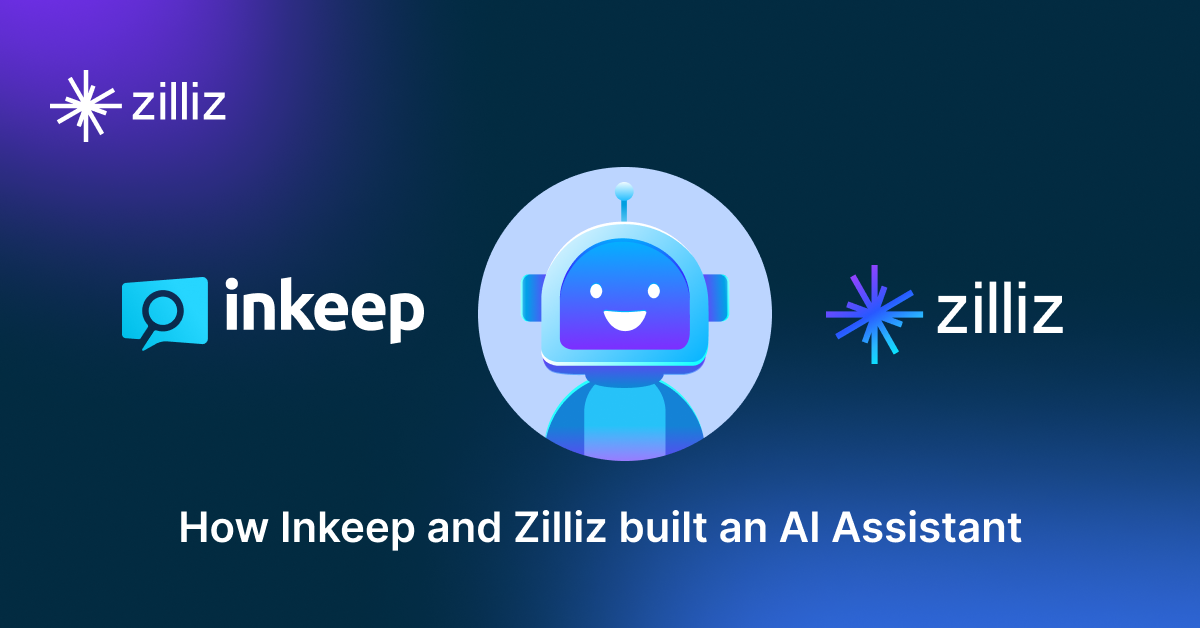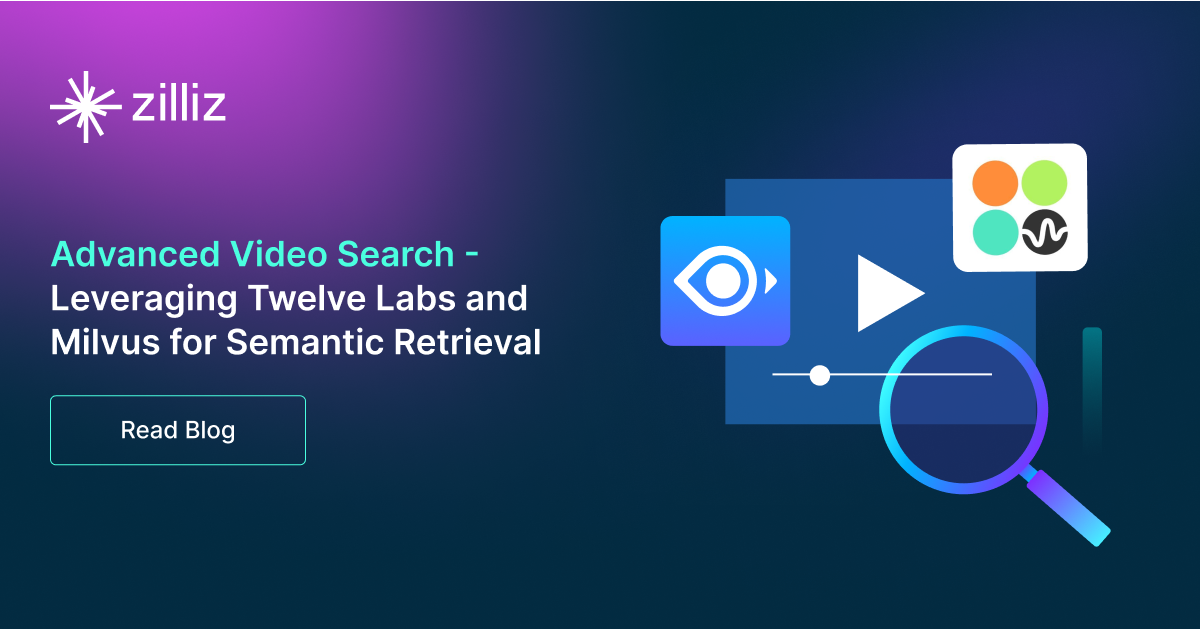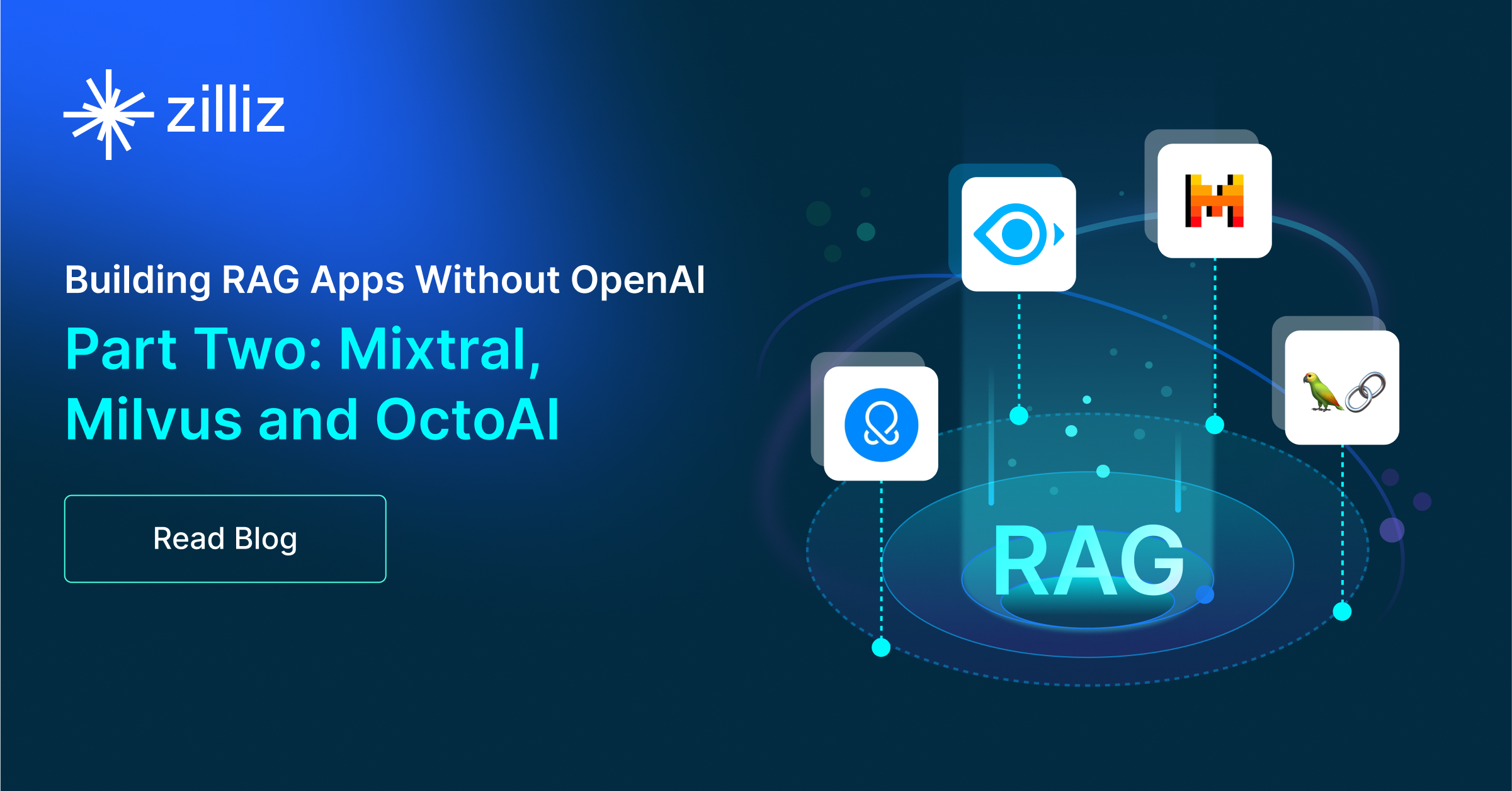Build RAG Chatbot with LangChain, OpenSearch, Google Vertex AI Claude 3 Sonnet, and voyage-3-lite
Introduction to RAG
Retrieval-Augmented Generation (RAG) is a game-changer for GenAI applications, especially in conversational AI. It combines the power of pre-trained large language models (LLMs) like OpenAI’s GPT with external knowledge sources stored in vector databases such as Milvus and Zilliz Cloud, allowing for more accurate, contextually relevant, and up-to-date response generation. A RAG pipeline usually consists of four basic components: a vector database, an embedding model, an LLM, and a framework.
Key Components We'll Use for This RAG Chatbot
This tutorial shows you how to build a simple RAG chatbot in Python using the following components:
- LangChain: An open-source framework that helps you orchestrate the interaction between LLMs, vector stores, embedding models, etc, making it easier to integrate a RAG pipeline.
- OpenSearch: An open-source search and analytics suite derived from Elasticsearch. It offers robust full-text search and real-time analytics, with vector search available as an add-on for similarity-based queries, extending its capabilities to handle high-dimensional data. Since it is just a vector search add-on rather than a purpose-built vector database, it lacks scalability and availability and many other advanced features required by enterprise-level applications. Therefore, if you prefer a much more scalable solution or hate to manage your own infrastructure, we recommend using Zilliz Cloud, which is a fully managed vector database service built on the open-source Milvus and offers a free tier supporting up to 1 million vectors.)
- Google Vertex AI Claude 3 Sonnet: This advanced AI model focuses on enhancing generative capabilities for creative applications. It merges powerful language understanding with customizable prompts to generate contextually relevant and coherent text. Ideal for marketing content, storytelling, and interactive AI experiences, it balances creativity with precision to meet diverse user needs.
- Voyage-3-Lite: This model is designed for resource-constrained environments, offering a lightweight and efficient solution for various NLP tasks. It excels in applications such as chatbots, content generation, and real-time text analysis, providing quick responses while maintaining a balance between performance and computational efficiency. Ideal for developers needing high throughput with limited resources.
By the end of this tutorial, you’ll have a functional chatbot capable of answering questions based on a custom knowledge base.
Note: Since we may use proprietary models in our tutorials, make sure you have the required API key beforehand.
Step 1: Install and Set Up LangChain
%pip install --quiet --upgrade langchain-text-splitters langchain-community langgraph
Step 2: Install and Set Up Google Vertex AI Claude 3 Sonnet
pip install -qU "langchain[google-vertexai]"
# Ensure your VertexAI credentials are configured
from langchain.chat_models import init_chat_model
llm = init_chat_model("claude-3-sonnet@20240229", model_provider="google_vertexai")
Step 3: Install and Set Up voyage-3-lite
pip install -qU langchain-voyageai
import getpass
import os
if not os.environ.get("VOYAGE_API_KEY"):
os.environ["VOYAGE_API_KEY"] = getpass.getpass("Enter API key for Voyage AI: ")
from langchain-voyageai import VoyageAIEmbeddings
embeddings = VoyageAIEmbeddings(model="voyage-3-lite")
Step 4: Install and Set Up OpenSearch
pip install --upgrade --quiet opensearch-py langchain-community
from langchain_community.vectorstores import OpenSearchVectorSearch
opensearch_vector_search = OpenSearchVectorSearch(
"http://localhost:9200",
"embeddings",
embedding_function
)
Step 5: Build a RAG Chatbot
Now that you’ve set up all components, let’s start to build a simple chatbot. We’ll use the Milvus introduction doc as a private knowledge base. You can replace it with your own dataset to customize your RAG chatbot.
import bs4
from langchain import hub
from langchain_community.document_loaders import WebBaseLoader
from langchain_core.documents import Document
from langchain_text_splitters import RecursiveCharacterTextSplitter
from langgraph.graph import START, StateGraph
from typing_extensions import List, TypedDict
# Load and chunk contents of the blog
loader = WebBaseLoader(
web_paths=("https://milvus.io/docs/overview.md",),
bs_kwargs=dict(
parse_only=bs4.SoupStrainer(
class_=("doc-style doc-post-content")
)
),
)
docs = loader.load()
text_splitter = RecursiveCharacterTextSplitter(chunk_size=1000, chunk_overlap=200)
all_splits = text_splitter.split_documents(docs)
# Index chunks
_ = vector_store.add_documents(documents=all_splits)
# Define prompt for question-answering
prompt = hub.pull("rlm/rag-prompt")
# Define state for application
class State(TypedDict):
question: str
context: List[Document]
answer: str
# Define application steps
def retrieve(state: State):
retrieved_docs = vector_store.similarity_search(state["question"])
return {"context": retrieved_docs}
def generate(state: State):
docs_content = "\n\n".join(doc.page_content for doc in state["context"])
messages = prompt.invoke({"question": state["question"], "context": docs_content})
response = llm.invoke(messages)
return {"answer": response.content}
# Compile application and test
graph_builder = StateGraph(State).add_sequence([retrieve, generate])
graph_builder.add_edge(START, "retrieve")
graph = graph_builder.compile()
Test the Chatbot
Yeah! You've built your own chatbot. Let's ask the chatbot a question.
response = graph.invoke({"question": "What data types does Milvus support?"})
print(response["answer"])
Example Output
Milvus supports various data types including sparse vectors, binary vectors, JSON, and arrays. Additionally, it handles common numerical and character types, making it versatile for different data modeling needs. This allows users to manage unstructured or multi-modal data efficiently.
Optimization Tips
As you build your RAG system, optimization is key to ensuring peak performance and efficiency. While setting up the components is an essential first step, fine-tuning each one will help you create a solution that works even better and scales seamlessly. In this section, we’ll share some practical tips for optimizing all these components, giving you the edge to build smarter, faster, and more responsive RAG applications.
LangChain optimization tips
To optimize LangChain, focus on minimizing redundant operations in your workflow by structuring your chains and agents efficiently. Use caching to avoid repeated computations, speeding up your system, and experiment with modular design to ensure that components like models or databases can be easily swapped out. This will provide both flexibility and efficiency, allowing you to quickly scale your system without unnecessary delays or complications.
OpenSearch optimization tips
To optimize OpenSearch in a Retrieval-Augmented Generation (RAG) setup, fine-tune indexing by enabling efficient mappings and reducing unnecessary stored fields. Use HNSW for vector search to speed up similarity queries while balancing recall and latency with appropriate ef_search and ef_construction values. Leverage shard and replica settings to distribute load effectively, and enable caching for frequent queries. Optimize text-based retrieval with BM25 tuning and custom analyzers for better relevance. Regularly monitor cluster health, index size, and query performance using OpenSearch Dashboards and adjust configurations accordingly.
Google Vertex AI Claude 3 Sonnet optimization tips
Claude 3 Sonnet on Google Vertex AI balances efficiency and reasoning power, making it a great choice for general-purpose RAG setups. Optimize retrieval by dynamically adjusting the number of retrieved documents based on query complexity to maintain context quality. Keep prompts concise and well-structured, avoiding redundancy. Set temperature between 0.1 and 0.3 to balance factual consistency and response diversity. Cache commonly used queries to minimize latency and reduce token costs. Take advantage of Google’s autoscaling features to manage variable workloads. If deploying multiple models, position Sonnet as the mid-tier option, handling moderately complex queries without the computational overhead of Opus.
voyage-3-lite optimization tips
voyage-3-lite is optimized for speed and efficiency, making it a strong choice for low-latency RAG applications. Improve retrieval by minimizing the number of retrieved documents while maintaining relevance using adaptive filtering techniques. Keep prompts concise and to the point, avoiding redundant context to reduce processing overhead. Set temperature between 0.1 and 0.2 to prioritize factual accuracy and prevent unnecessary response variation. Use caching to reduce repeated API calls for common queries. Implement response streaming to improve user experience in real-time applications. Optimize resource usage by running voyage-3-lite in high-throughput scenarios where speed is prioritized over deep reasoning, reserving larger models for more complex analysis.
By implementing these tips across your components, you'll be able to enhance the performance and functionality of your RAG system, ensuring it’s optimized for both speed and accuracy. Keep testing, iterating, and refining your setup to stay ahead in the ever-evolving world of AI development.
RAG Cost Calculator: A Free Tool to Calculate Your Cost in Seconds
Estimating the cost of a Retrieval-Augmented Generation (RAG) pipeline involves analyzing expenses across vector storage, compute resources, and API usage. Key cost drivers include vector database queries, embedding generation, and LLM inference.
RAG Cost Calculator is a free tool that quickly estimates the cost of building a RAG pipeline, including chunking, embedding, vector storage/search, and LLM generation. It also helps you identify cost-saving opportunities and achieve up to 10x cost reduction on vector databases with the serverless option.
 Calculate your RAG cost
Calculate your RAG cost
What Have You Learned?
By diving into this tutorial, you’ve unlocked the magic of building a powerful RAG system from the ground up! You learned how LangChain acts as the glue that ties everything together, orchestrating workflows to connect your data, models, and user queries seamlessly. OpenSearch stepped in as your trusty vector database, storing embeddings generated by the lightweight yet mighty voyage-3-lite model, which transformed text into numerical representations for lightning-fast retrieval. Then came Google Vertex AI’s Claude 3 Sonnet, the LLM superstar that synthesized retrieved information into human-like responses, blending accuracy with creativity. Together, these tools formed a pipeline that turns raw data into actionable insights—whether you’re answering complex questions, summarizing documents, or powering a chatbot. Plus, you picked up pro tips like optimizing chunk sizes for embeddings and using metadata filtering in OpenSearch to boost efficiency. And let’s not forget the free RAG cost calculator to estimate expenses and scale smartly—because building smart means building sustainably!
Now that you’ve seen how these pieces fit together, the real adventure begins. You’ve got the blueprint to customize this pipeline for your own projects, experiment with different models, or fine-tune retrieval strategies. Imagine enhancing customer support, automating research, or creating dynamic content—all with a system that learns and adapts. The tools are in your hands, and the possibilities are endless. So go ahead—tweak, iterate, and innovate! Whether you’re a curious developer or a problem-solving entrepreneur, your next RAG application could be the game-changer someone needs. Start building, share what you create, and don’t forget to celebrate every “aha!” moment along the way. The future of intelligent applications is yours to shape—let’s make it awesome! 🚀
Further Resources
🌟 In addition to this RAG tutorial, unleash your full potential with these incredible resources to level up your RAG skills.
- How to Build a Multimodal RAG | Documentation
- How to Enhance the Performance of Your RAG Pipeline
- Graph RAG with Milvus | Documentation
- How to Evaluate RAG Applications - Zilliz Learn
- Generative AI Resource Hub | Zilliz
We'd Love to Hear What You Think!
We’d love to hear your thoughts! 🌟 Leave your questions or comments below or join our vibrant Milvus Discord community to share your experiences, ask questions, or connect with thousands of AI enthusiasts. Your journey matters to us!
If you like this tutorial, show your support by giving our Milvus GitHub repo a star ⭐—it means the world to us and inspires us to keep creating! 💖
- Introduction to RAG
- Key Components We'll Use for This RAG Chatbot
- Step 1: Install and Set Up LangChain
- Step 2: Install and Set Up Google Vertex AI Claude 3 Sonnet
- Step 3: Install and Set Up voyage-3-lite
- Step 4: Install and Set Up OpenSearch
- Step 5: Build a RAG Chatbot
- Optimization Tips
- RAG Cost Calculator: A Free Tool to Calculate Your Cost in Seconds
- What Have You Learned?
- Further Resources
- We'd Love to Hear What You Think!
Content
Vector Database at Scale
Zilliz Cloud is a fully-managed vector database built for scale, perfect for your RAG apps.
Try Zilliz Cloud for Free


